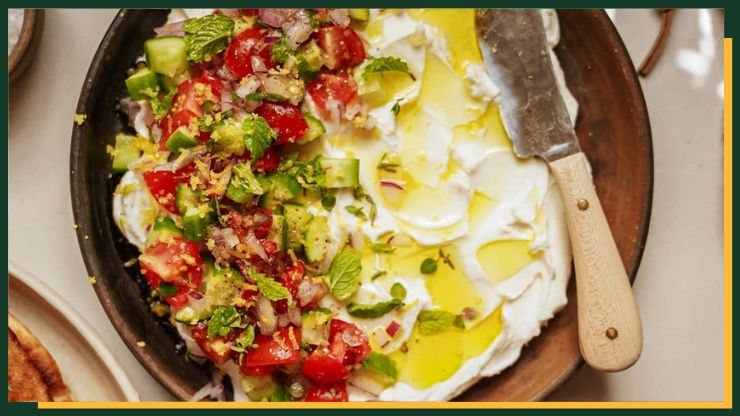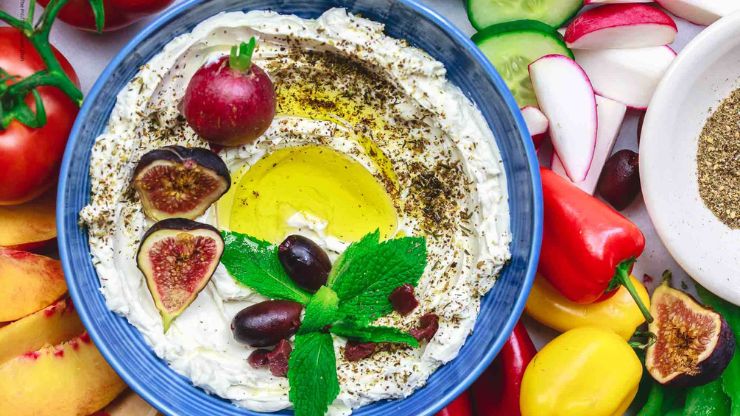How to Make Lebna – Labneh, a versatile and creamy Middle Eastern delight, holds a special place in culinary traditions. This guide is your passport to crafting the perfect Labneh at home, unlocking the secrets of this cherished dairy creation.
By harnessing the simplicity of yogurt, a pinch of salt, and a bit of patience, you’ll embark on a journey to transform basic ingredients into a rich and tangy spread. Whether you’re a kitchen novice or a seasoned cook, this step-by-step tutorial will demystify the art of Labneh-making, offering optional twists to suit your palate.
Elevate your culinary repertoire by mastering the craft of homemade Labneh, ready to grace your table with its luscious texture and delightful flavors.
Table of Contents
ToggleIngredients
- Yogurt:
- 2 cups of full-fat yogurt (avoid flavored or sweetened varieties)
- Salt:
- 1 teaspoon of salt (adjust to taste)
- Optional Ingredients for Flavor Variations:
- Olive Oil:
- Extra virgin olive oil for drizzling
- Herbs:
- Fresh mint, thyme, or oregano (chopped)
- Garlic:
- 1-2 cloves (minced or crushed)
- Za’atar Spice Blend:
- 1-2 teaspoons for added Middle Eastern flair
- Olive Oil:
Also, Read – Probiotic Red Horseradish Sauce
Don't just scroll, subscribe!
BuzzTrail's unique web-stories are the cure for boredom you've been waiting for.
Equipment
- Cheesecloth or Muslin Cloth:
- To strain the yogurt and achieve the desired thickness.
- Fine-Mesh Strainer or Colander:
- Placed over a bowl to allow the yogurt to drain.
- Bowl:
- For catching the liquid (whey) that drains from the yogurt.
- Rubber Band or Kitchen Twine:
- To secure the cheesecloth or muslin cloth over the strainer or colander.
- Spoon or Stirring Utensil:
- For mixing and stirring the yogurt before straining.
How to Make Lebna

- Prepare Yogurt:
- Use plain, whole-milk yogurt for the best results. Avoid yogurt with added thickeners or sweeteners.
- You can use store-bought yogurt or make your own by heating milk to about 180°F (82°C), cooling it to around 110°F (43°C), and then adding a small amount of plain yogurt with live cultures as a starter. Let it incubate for 4-8 hours until set.
- Add Salt:
- Mix in the salt with the yogurt. This adds flavor to the lebna. Adjust the salt according to your taste preferences.
- Strain the Yogurt:
- Place a strainer or colander over a deep bowl.
- Line the strainer with a double layer of cheesecloth or a clean kitchen towel. Make sure it’s large enough to fold over the yogurt.
- Transfer Yogurt to Cheesecloth:
- Pour the yogurt into the lined strainer.
- Fold and Cover:
- Fold the excess cheesecloth or towel over the yogurt to cover it completely.
- Drain Excess Whey:
- Place the setup in the refrigerator and let it drain for at least 12 hours or overnight. The longer it drains, the thicker the lebna will be.
- Check Consistency:
- After the desired time, open the cheesecloth or towel and check the consistency. It should be thick and spreadable.
- Transfer to a Container:
- Scoop the strained lebna into a clean container with a lid.
- Store:
- Refrigerate the lebna. It can be stored for about 1-2 weeks. The longer it sits, the thicker it will become.
- Serve:
- Serve the lebna as a dip, spread it on bread, or use it in various dishes. You can drizzle olive oil over the top and add herbs for extra flavor.
Also, Read – How to Make Probiotic Creme Fraiche
Popularity and Versatility of Labneh in Middle Eastern Cuisine
Labneh holds a revered status in Middle Eastern cuisine, renowned for its widespread popularity and versatile applications. Its creamy texture and tangy flavor make it a staple in both traditional and modern culinary landscapes. Here’s a glimpse into why Labneh is cherished:
- Culinary Versatility:
- Labneh is incredibly versatile, serving as a blank canvas for various culinary creations. It can be enjoyed as a spread, dip, or even formed into balls and marinated.
- Traditional Breakfast Dish:
- Commonly consumed during breakfast, Labneh pairs seamlessly with flatbreads, olives, and fresh vegetables, offering a nutritious and satisfying start to the day.
- Dip and Condiment:
- Labneh transforms into a delectable dip when infused with herbs, garlic, or spices, making it a favorite accompaniment for pita bread, chips, or vegetable crudités.
- Sandwich and Wrap Filling:
- Spreadable and rich, Labneh makes an excellent alternative to mayonnaise or other spreads in sandwiches and wraps, adding a distinctive Middle Eastern flair.
- Dessert Component:
- Labneh’s versatility extends to desserts, where it can be sweetened with honey or combined with fruits for a delightful treat.
- Cultural Significance:
- Labneh is deeply rooted in Middle Eastern culinary traditions, reflecting the region’s emphasis on dairy products in its gastronomy.
- Healthy and Probiotic:
- As a dairy product, Labneh is a good source of protein and probiotics, contributing to digestive health.
Conclusion
In conclusion, crafting Labneh at home unlocks a journey into the heart of Middle Eastern culinary tradition. With its creamy texture and tangy notes, Labneh stands as a versatile delight, elevating breakfasts, dips, and desserts. This simple yet rewarding process not only fills your kitchen with the aroma of tradition but also offers a canvas for personal creativity. Embrace the joy of homemade Labneh, a testament to the rich and diverse tapestry of flavors that Middle Eastern cuisine brings to the table.
FAQs
Can I use low-fat yogurt to make Labneh?
Can I use low-fat yogurt to make Labneh?
While full-fat yogurt is recommended for a creamier result, you can use low-fat yogurt. Keep in mind that the texture may be slightly different.
How long should I strain the yogurt to achieve the desired thickness?
How long should I strain the yogurt to achieve the desired thickness?
Straining time varies based on personal preference. Check the thickness after 8-12 hours; for a thicker Labneh, you can strain for up to 24 hours.
Can I use Greek yogurt instead of regular yogurt?
Can I use Greek yogurt instead of regular yogurt?
Yes, you can use Greek yogurt, but it is already strained, so the process may take less time.

